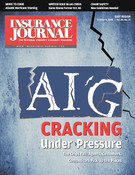Boston-based Liberty Mutual Group is not pleased with Standard & Poor’s announcement that it is lowering the company’s financial strength rating from ‘A’ to ‘A-‘ with a stable outlook, following Liberty’s completion of its acquisition of Safeco.
The company called the action “both a surprise and disservice to Liberty Mutual and our policyholders.” In a bulletin the insurer also noted that S&P’s rating action was in “contradiction of prior announcements.”
According to Liberty Mutual, S&P said in April when the Safeco deal was announced that it “expected to affirm Liberty’s ratings if its capitalization was not materially below what is required for the current rating and were satisfied with Liberty’s integration efforts of Safeco.”
S&P had also indicated on July 23 that it “expected to affirm Liberty’s ratings ‘if capital and earnings remain strong;’ but could lower ratings, ‘if pro forma capital and earnings were materially below the appropriate level for the rating.'”
Liberty Mutual pointed out that its reported pre-tax operating income was nearly $900 million in the first six months of 2008, which was “approximately 3 percent higher than the same period in 2007. In addition, Liberty said its “pro forma capital adequacy using Standard & Poor’s published criteria indicates Liberty’s capital is adequate to maintain our ‘A’ rating.”
Liberty also took a swipe at S&P by referring to recent criticisms of its actions, and those of Moody’s Investors Service, for acting too prematurely (or conversely for being too slow) in the current financial crisis centered on AIG and Lehman Brothers. Citing the “turbulence and uncertainty in today’s financial and credit markets,” Liberty said it had “focused a negative spotlight” on S&P’s rating process. “As a result,” said the bulletin, “one would have hoped that now more than ever Standard & Poor’s would have recognized its fiduciary obligation to act in a consistent, coherent and accurate manner. Unfortunately, they have not.”
As an example Liberty cited S&P’s use of “return on revenue” as a “meaningful measure of relative profitability, versus return on capital.” The company charged that this “ignores the relative risks associated with the different sources of revenue in different companies, and the capital required to support the revenues.”
In addition Liberty cited S&P’s reference to aggressive pricing, which, it said, “ignores the ‘strong’ rating from Standard and Poor’s based upon its own detailed review of Liberty’s underwriting risk management controls, issued only seven months ago.”
Was this article valuable?
Here are more articles you may enjoy.


 Supreme Court Overturns Chevron Rule in Blow to Regulators
Supreme Court Overturns Chevron Rule in Blow to Regulators  QBE to Non-Renew $500M of North American Mid-Market Biz
QBE to Non-Renew $500M of North American Mid-Market Biz  Zurich to Buy AIG’s Travel Insurance Business for $600 Million
Zurich to Buy AIG’s Travel Insurance Business for $600 Million  Allstate, Nationwide Post Dramatic Q12024 Homeowners Loss Ratio Drops: S&P
Allstate, Nationwide Post Dramatic Q12024 Homeowners Loss Ratio Drops: S&P 


